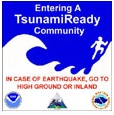So far we've talked about the physics of tsunamis and you have investigated tsunami data and made some calculations about tsunami speeds. What's the current state of the art in terms of tsunami risk and hazard mitigation? Where are some other sites in the Atlantic Ocean where tsunamigenic potential lurks?

Readings relevant to the paper assignment
The following readings are either freely available online if they are linked from this page, or if they are not in the public domain then they are linked from Canvas. You should at least skim these articles because they deal with potential Atlantic Ocean tsunamigenic sites.
- Nealon, J. W., & Dillon, W. P. (2001, April). Earthquakes and Tsunamis in Puerto Rico and the U.S. Virgin Islands. U.S. Geological Society. Retrieved June 2, 2008, from http://pubs.usgs.gov/fs/fs141-00/fs141-00.pdf.
- Teeuw, R., Rust, D., Solana, C., & Dewdney, C. (2009). Large Coastal Landslides and Tsunami Hazard in the Caribbean. Eos, 90 (10), 81-82.
- Driscoll, N. W., Weissel, J. K., & Goff, J. A. (2000). Potential for large-scale submarine slope failure and tsunami generation along the U.S. mid-Atlantic Coast. Geology, 28(5), 407-410.
- Gisler, G., Weaver, R., & Gittings, M. (2006). Sage calculations of the tsunami threat from La Palma. Science of Tsunami Hazards, 24(4), 288-301.
- Pérez-Torrado, F. J., Paris, R., Cabrera, M. C., Schneider, J., Wassmer, P., Carracedo, J., et al. (2006). Tsunami deposits related to flank collapse in oceanic volcanoes: The Agaete Valley evidence, Gran Canaria, Canary Islands. Marine Geology, 227(1-2), 135-149.
- Wendell, J.(2015). Mysterious boulders suggest ancient 800-foot-tall tsunami.Eos, 96,doi:10.1029/2015EO036845. Published on 2 October 2015.
The following readings will help you become conversant with the way tsunami warning systems work, and what has been done since the 2004 Sumatra-Andaman tsunami:
- Pacific Tsunami Warning Center History
National Weather Service, Pacific Tsunami Warning Center.
Accessed: 2010-09-13. - Pacific Tsunami Warning Center Responsibilities
National Weather Service, Pacific Tsunami Warning Center.
Accessed: 2010-09-13. - Tsunami-Forecasting System Tested by Recent Subduction-Zone Earthquakes
Geist, Eric, Titov, Vasily, Kelly, Annabel, and Gibbons, Helen. USGS, Sound Waves.
Accessed: 2008-03-12. - Gower, J., & Gonzalez, F. (2006). U.S. warning system detected the Sumatra tsunami. Eos, 87(10), 105, 108.
- Tracking Tsunamis (2009) AGU video
- Schiermeier, Q. (2009). Tsunami Watch. Nature, 462, 968-969.